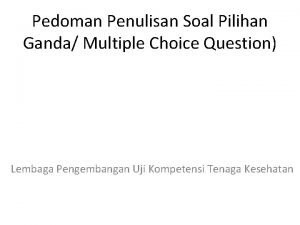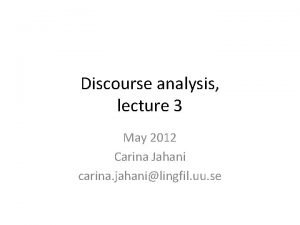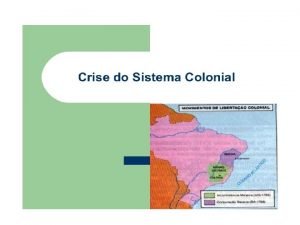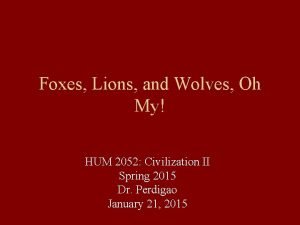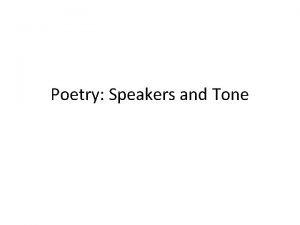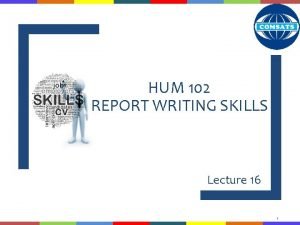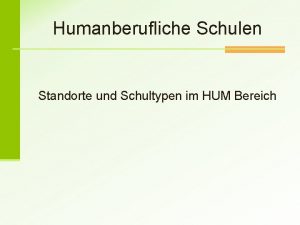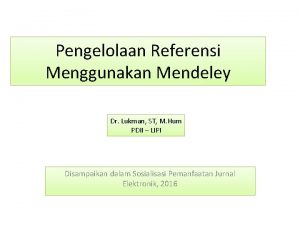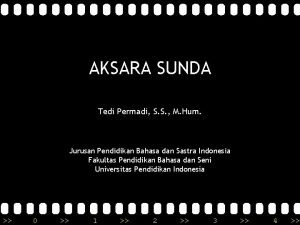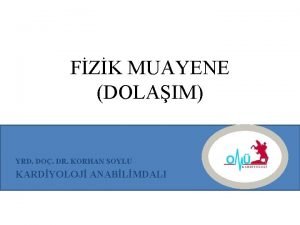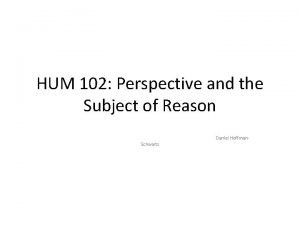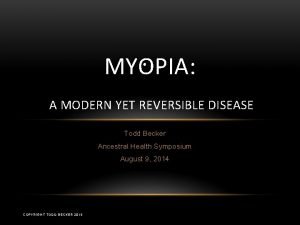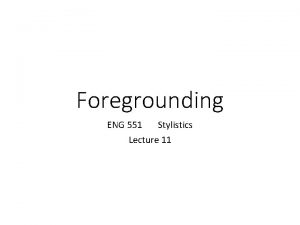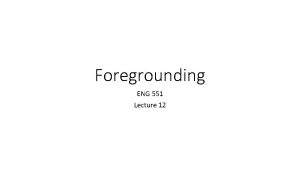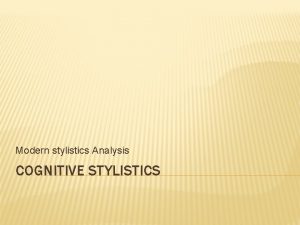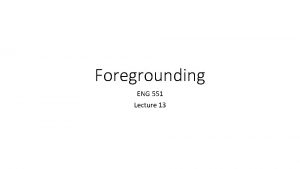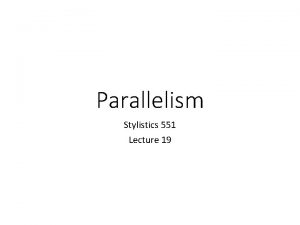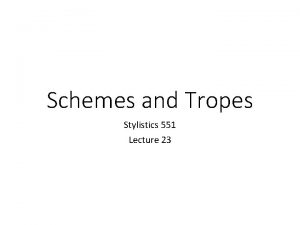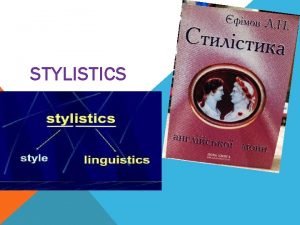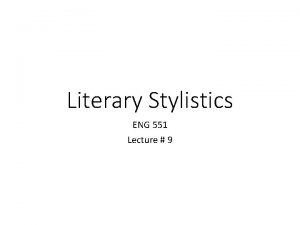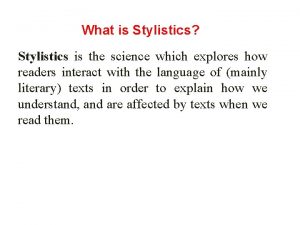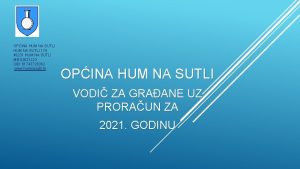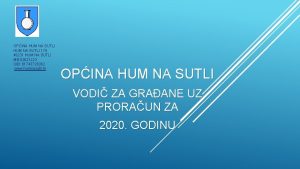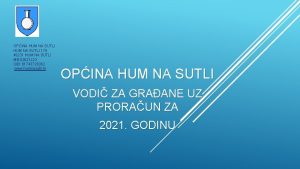5013 HUM STYLISTICS Option 1 focusing on foregrounding





















- Slides: 21

5013 HUM – STYLISTICS Option 1: focusing on foregrounding and conceptual metaphor theory Sabah, Diya, Olivia, Karan and Mankirat

INTRODUCTION

• This presentation will explore the selected extract of Haruki Murakami's Kafka on the Shore, focusing on Foregrounding and Conceptual Metaphor Theory. • Simpson describes Foregrounding as "a form of textual patterning which is motivated particularly for literaryaesthetic purpose", that typically involves a type of "distortion […] which deviates from a linguistic form or, where an aspect of the text is bought to the fore through repetition or parallelism" (Simpson 2004/2014: 52). INTRODUCTION • Traditionally, metaphors were considered as purely linguistic and described as "a process of mapping between two different conceptual domains […] known as the target domain and the source domain". Conceptual Metaphor Theory explores the metaphors we hold in our minds and how they are represented linguistically. (Simpson 2004/2014: 43). • These methods will be explored further and applied to our chosen extract.

CONTEXT

• Murakami’s Kafka on the Shore, published in Japan in 2002, was nominated “The 10 Best Books of 2005” (English translation year). • The novel consists of two interrelated plots in which the narrative runs back and forth between the two. “KAFKA ON THE SHORE” HARUKI MURAKAMI: THE CONTEXT The odd-numbered chapters tell Kafka’s story: - A fifteen-year old who runs away from his father’s house to escape an oedipal curse, embarking on a quest to find his mother and sister. The even-numbered chapters tell Nakata’s story: - A part-time finder of lost cats, finally choosing to travel on the road to continue his work. • The two character’s paths inevitably converge, creating a creative world involving talking cats, spirits and fish falling from the sky.

CONCEPTUAL METAPHOR THEORY

CONCEPTUAL METAPHOR THEORY Source Domain: Sandstorm What is the conceptual metaphor ? (Concrete) LIFE IS A JOURNEY Target Domain: Life Experiences (Abstract) MAPPING Target Domain: Properties of a Sandstorm: • Uncontrollable • Impactful • Negative • Chaotic These properties are being mapped onto the target domain • Life Experiences are also uncontrollable • These experiences impact the way we move forward in life

Within this storm, the sand is being compared to the idea of fate. It has been personified and given human characteristics, creating a vivid textual effect of this non-human entity. This suggests that fate is something that is out of our hands, it is not controllable just like a sandstorm. Therefore, the purpose of this storm in this extract is to advice Crow to make the correct decisions in life and learn from each experience. The textual effect of this metaphor implies that everyone has something 'inside' us that makes us different from one another. Therefore, this young boy can try and change his pathway in life, but the result will be the same because the storm will "adjust" and continue to "chase" him. The textual effect of this analysis demonstrates that metaphors not only tells us about something but makes us feel it. Readers can visualise this sandstorm not only as a storm but as an example of life experiences. As the storm progresses, this storm is not an ordinary storm as it is "inside" Crow. The textual effect of this metaphor creates a clear emotional connection between the young boy and the sandstorm. It is giving this young boy the opportunity to accept his fate and gain some sort of control of his life by stepping 'right inside the storm' and to 'walk through it, step by step'. It may imply that Crow is much stronger and more courageous than he thinks. The use of personification in this extract creates a stronger connection between the source domain and the target domain. The reason for this is because “conceptual elements of the source domain correspond to constituent elements of the target domain”(Burke 2014: 214). In other words, the properties of a sandstorm being uncontrollable and chaotic correlate to the properties of life experiences. The textual effect of this extract is to show readers how two different ideas can combine together to create persuasive conceptual text.

The concept that is motivating this conceptual metaphor is the idea of something that is out of your control and is foreshadowing the idea of it ultimately destroying you. It immediately gives a negative ambiance and gives the impression that something bad is going to occur. It also personifies the sandstorm as the sandstorm won’t literally swallow the boy up. Lakoff and Johnson believe that a metaphor is a 'matter of extraordinary language rather than ordinary language' (Lakoff and Johnson 1980: 453). This is something that we can see through the conceptual metaphors used here as we wouldn’t usually use these metaphors in everyday language. This further makes the text more impactful and meaningful as it creates an imaginative experience for the reader, so they are able to understand each situation and scenario through these metaphors. The conceptual metaphor being motivated here is the idea of pain and being tortured by something so excruciating that it feels as though you are being ‘cut through flesh’. By implying that this experience will cut through your human skin instantly creates a sinister and malevolent textual effect. This is due to the readers being aware that the razor blades are non-existent, however, it is instead referring to the intensity of the storm, so we know, through The conceptual metaphor motivated here, is the idea of guilt. This is because the use of ‘blood’ which is the colour red, connotates danger and sin and is not usually associated with anything positive.

FOREGROUNDING

DEFAMILIARIZATION • Before understanding the concept of foregrounding, understanding the concept of defamiliarization enables linguists to analyze texts. Defamiliarization Internal Deviation Foregrounding Deviation Parallelism External Deviation • Defamiliarization: the technique of ‘making strange’ where the ‘purpose of art is to overcome the deadening effects of habitat by representing familiar things in unfamiliar ways’ (Lodge 1992)

FOREGROUNDING • Idea that individuals react differently to the same text because we do not share the exact same ‘schema’ which is essentially our conventional ways of viewing the world (Gregoriou 2017: 88) • What is deviation? ‘refers to an encounter with something different than what is expected, or indeed different from regulations of some kind’ (Gregoriou 2017: 89) There are 2 types of deviation, internal and external. • Internal deviation: deviation from patterns established within the text • External deviation: deviation from patterns established from wider expectations and conventions

INTERNAL DEVIATION • Internal deviation usually focuses on the structure and style of the text and how it differentiates from the norm set up by the text itself. • Internal deviation is often considered the opposite of parallelism. Changes in the style of font from regular to bold, signifying a change in the receiver of the narrator’s speech. Bold font is used when the narrator is addressing the reader whilst regular font is used when narrating the story. Another example of internal deviation is the use of varied sentence lengths. By having a mixture of both long and short sentences reflects the sporadic mindset of the narrator and how like a sandstorm, his mentality is wildly out of control.

EXTERNAL DEVIATION • External deviation is found in a text usually through our knowledge of factors such as context, genre and the time period of the text and although stylistics is based on the objective analysis of a text, these factors unknowingly contribute to our analysis. • The use of the simile ‘fate is like a sandstorm’ is an unexpected comparison as it creates a negative uncertainty about the character’s destiny rather than an undecided one

PARALLELISM • Parallelism can be seen as an unexpected regularity in language or in other words can be seen as repetition. It creates a pattern within the text which enables readers to engage more with the text. Examples of parallelism can be found in literary works as well as in ordinary conversations (Literary Devices 2020) The repetition here highlights the main idea of defamilarization of ‘making strange’. This is because it would be unusual for a sentence like this to be repeated. It moves away from the norms of a text.

Narrator is repeating what Crow says and goes into his own monologue which is highlighted in bold. This example of parallelism then becomes effective because it is portraying the thought process of the narrator. As well as this, the parallelism here becomes memorable for the reader, in particular, the sandstorm. x The parallel here allows for the sentence to flow naturally. If this was written as ‘There’s no sun there, no moon, no direction and no sense of time. ’ it would take away the natural flow and can then come across as awkward. The repetition of ‘you’ in this grammatical structure creates this sense of urgency. As well as this, the structure provides a rhythm which makes it easier for the reader to follow alongside keeping them engaged.

The repetition here can come across as quite unusual as well as chaotic. This can then represent the aftermath of the chaotic storm and the state of the mind of the narrator.

CONCLUSION

• To conclude, Murakami uses the metaphor of a sandstorm to convey several notions and emotional experiences that he intends the reader to visualize. CONCLUSION • Using Conceptual Metaphor Theory, we can see that an emotional connection is formed, from the young boy's experiences to the chaos of a sandstorm that the mind imagines. Despite many readers not having experienced this firsthand, the conceptual metaphor allows this reference to be widely understood. • As well as this, examples of internal deviation, external deviation, parallelism and repetition can be found throughout the extract that contribute to several effects on the reader such as : negative connotations, making strange and rhythm.

REFERENCES

Lakoff, G. , & Johnson, M. (1980). Conceptual Metaphor in Everyday Language. The Journal of Philosophy, 77(8), 453 -486. Literary Devices (2020) Parallelism [online] available from <https: //literarydevices. net/parallelism/> [18 February 2020] REFERENCES Simpson, P. (2004/2014) Stylistics. A Resource Book for Students. London: Routledge. Talkoff, E. (2018) Kafka on the Shore Plot Summary [online] available from < https: //www. litcharts. com/lit/kafka-on-the-shore/summary > [20/02/20] Burke, M. (2014) The Routledge Handbook of Stylistics. [online] New York: Routledge. Available from <https: //ebookcentral. proquest. com/lib/coventry/reader. action? doc. ID=766015# > [12 February 2020]
 What are the principles of stylistics
What are the principles of stylistics Bssd adalah
Bssd adalah Long call short call
Long call short call Foregrounding and backgrounding in discourse analysis
Foregrounding and backgrounding in discourse analysis Conjuração mineira resumo
Conjuração mineira resumo Oh so hum
Oh so hum Hum schulen
Hum schulen Speaker of the poem
Speaker of the poem Hum 102
Hum 102 Alice hum
Alice hum Hum schultyp
Hum schultyp Dr. lukman, s.t., m.hum.
Dr. lukman, s.t., m.hum. Abe hum pen thin height
Abe hum pen thin height Kaligrafi aksara sunda
Kaligrafi aksara sunda S3 gallop ritmi nedir
S3 gallop ritmi nedir Humanities art appreciation
Humanities art appreciation Hum 102
Hum 102 Ho hum when he's finished pecking meaning
Ho hum when he's finished pecking meaning Mkm.m
Mkm.m Project integration management example
Project integration management example Different types of microscope and their uses
Different types of microscope and their uses Print pushing eye exercise
Print pushing eye exercise

